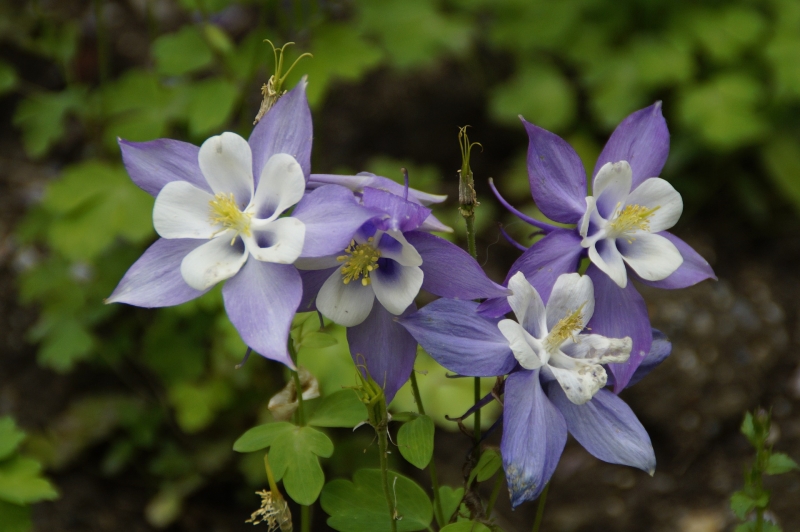Imagine your backyard garden bursting with color, and filled with scintillating scents. Beautiful flowers and plants thrive in Colorado, as long as you plant native flowers and plants for Denver and the Front Range. Here are some of the favorites.
Colorado’s State Flower: the Rocky Mountain Columbine
While every state has an “official” bud, few are as beautiful as Colorado’s. The Rocky Mountain columbine returns with its white and lavender buds every spring. They’re drought-tolerant, thrive in light shade to filtered sunlight, and prefer well-draining soil. These flowers grow quickly from seed and bloom in April through July. With many hybrids to choose from, you can add columbines to any garden or landscape for a diversity of color.
Backyard Beauties
Looking for a variety of garden wildflowers, grasses, shrubs, trees and plants for your property? The Colorado Native Plant Society has suggestions for bringing the Centennial State’s natural beauty to your backyard. Here are a few to consider:
Spring Blooming Perennials
- Blue flax (blue); Pasque flower (lavender)
- Prairie smoke (rose-pink)
- Prince’s plume (yellow)
- Wild verbena (lavender)
- Pussytoes (cream to rose-pink)
- Western wallflower (yellow/orange)
- Scarlet globemallow (orange-red)
Summer Blooming Perennials
- Chocolate flower (yellow)
- Blanket flower (yellow to orange-red)
- Aspen daisy (lavender/yellow)
- Black-eyed Susan (Golden yellow/brown)
- Purple prairie clover (magenta-purple)
- Scarlet gilia (red)
- Goldenrod (yellow)
- Purple coneflower (lavender)
- Sulphur flower (yellow)
- Pearly everlasting (white)
Perennials that Bloom in Late Summer/Early Fall:
- Purple poppy mallow (magenta)
- Bush morning glory (magenta)
- Desert four o’clock (rose-pink)
- Maximillian sunflower (yellow)
- Tansy aster (lavender)
Ornamental Grasses
Spice up your landscaping with a variety of ornamental grasses that are native to various regions of Colorado. If you’re looking for large, airy, fine-textured foliage or large blades, these types fit the bill:
- Alkali sacaton (grows 2-4 feet tall)
- Switchgrass (grows 3-5 feet tall)
- Western wheatgrass (grows 1-2.5 feet tall)
- Prairie cordgrass (grows 3-7 feet tall)
- Blue big-stem (2-7 feet tall)
- Indian grass (3-5 feet tall)
Tufted and small-mound ornamental grasses for Colorado landscapes include:
- Indian ricegrass (1-2 feet tall)
- Junegrass (1-2 feet tall)
- Needle-and-thread (1-2 feet tall)
- Mountain muhly (1/2 foot to 2 feet tall)
- Prairie dropseed (1-2 ½ feet tall)
- Side-oats grama (1-2 ½ feet tall)
Plants, Shrubs, and Trees
From deciduous to evergreen, whether tall or small, slender or wide, trees and shrubs in Colorado thrive outside. With so many species of plants, shrubs, and trees, here are just a few to consider for your landscape.
Looking for trees that can reach the sky? Check these out:
- Lanceleaf cottonwood (40-60 feet high)
- Narrowleaf cottonwood (24-60 feet high)
- Plains cottonwood (60-80 feet or higher)
- Ponderosa pine (60-80 feet or higher)
Large and Medium Deciduous Trees and Bushes
Trees
- Mountain ash (9-15 feet high)
- Silver buffaloberry (6-20 feet high)
- Thinleaf alder (18-24 feet high)
- Rocky Mountain juniper (5-40 feet high)
- Hawthorn (6-12 feet high)
- Mountain mahogany (5-15 feet high)
Shrubs
You can find many native species of small shrubs at nurseries and garden stores in the metro area. Look for these varieties:
- Common juniper (1-3 feet)
- Mountain ninebark (3-4 feet)
- Broom snakeweed (1 foot)
- Boulder raspberry (5 feet)
- Little leaf mountain mahogany (1-5 feet)
- Buckbrush (2 feet)
Planting indigenous Colorado greenery in your landscape or garden helps you and the environment. The vegetation adapts well to Colorado’s changing climates, soil conditions, and environment. Native species need little maintenance or water and are more resistant to pests and diseases than invasive plants. They also lure local wildlife — birds, pollinators such as bees and mammals (bunnies and squirrels.) Increasing urbanization leads to lost natural ecosystems. Planting native species ensures our natural resources will be around for the next generation.
Do you have questions about garden care? Please visit our Denver, CO page for more information.

